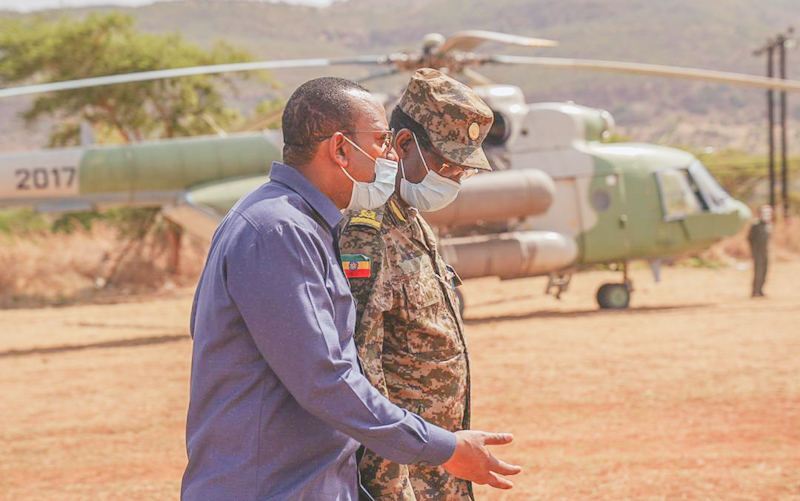 African based Finnish freelance journalist Liselott Lindstrom, mainly reporting for Finnish Broadcasting Company, had a chance to witness first-hand how the war and humanitarian crisis in the Ethiopian northern regional state of Tigray, a week before Ethiopian Defense Forces moved out of the regional state.
African based Finnish freelance journalist Liselott Lindstrom, mainly reporting for Finnish Broadcasting Company, had a chance to witness first-hand how the war and humanitarian crisis in the Ethiopian northern regional state of Tigray, a week before Ethiopian Defense Forces moved out of the regional state.
On her trip to Ethiopia’s Tigray regional state, she managed to meet Getachew Reda, the Advisor to the President of Tigray state.
Reda is a fire-spitting critic of Ethiopian Prime Minister Dr Abiy Ahmed.
Reda is also serving as the spokesperson for Tigray People’s Liberation Front (TPLF), which is rebranding itself as Tigray Defense Force (TDF).
In an exclusive conversation, Ms Lindstrom explained how she managed to meet Mr Reda while he was on the run against the Ethiopian defence force.
“It was just pure luck we ran into him. Or well, he wanted to be found,” Ms Lindstrom says.
“We wanted to speak to the TDF (TPLF)-soldiers and happened to come to the village where he was hiding,” Ms Lindstrom added.
Ms Lindstrom’s picture with the spokesperson is posted on the Finnish Broadcasting Company.
Her article fairly discussed the then scenes of TPLF fighters, the picture, however, sparked a lot of conversations among Ethiopians and the diaspora community on social media.
Some are trolls against the journalist as if she had another mission using journalism as a cover while others questioned how come the Finnish journalist managed to meet Getachew Reda while the Ethiopian Defense force is not able to capture him.
However, Ms Lindstrom said: “(she) did expect backlash… What was terrible to see is how the picture was used for propaganda against NGOs, and that was something I didn’t foresee.”
She added: “…contrary to what people are accusing me of, interviewing someone does not mean I support them…it is just journalism.”
I have been furiously attacked and threatened online since Sunday when my interview with @reda_getachew aired. I was in Ethiopia with journalist accreditation and with permission to report in Tigray. NGO’s have nothing to do with my reporting. I was doing my job.
— Liselott Lindström (@lliselott) June 29, 2021
A section of the media quotes “army sources” saying they killed the MSF-workers because of the picture of her and Reda, which is not true since they were killed before the story was aired.
In her article, the freelance journalist mentioned there was a fight taking place about 15 miles away from where she met Getachew Reda.
Ms Lindstrom visualized Getachew Reda “He was just a little man in a mountain village with some troops around. But, I, of course, only saw what I saw and not the bigger picture.”
She also added, “There was no way for me to assess if what he said was true when it comes to their gains and their claims of victory on the battlefield, but everything they said I put it in their mouths, (I) would never have stated it as a fact.”
Ethiopian defence force U-turn from Tigray regional state
Coincidently, a week later after the Finnish Freelance reporter left the country, the Ethiopian government announced it would withdraw the nation’s defence force out of Mekelle and most of the regional state borders on June 28, 2021, declaring a unilateral ceasefire which was immediately rejected by TPLF leaders.
The Ethiopian Defense force had captured Tigray Regional capital, Mekelle, on November 28, 2020, driving out the TPLF forces to the extremely rural villages. Exactly eight months before its current withdrawal.
On June 30, 2021, Ethiopian Prime Minister Dr Abiy Ahmed said his troops’ withdrawal was planned and took all the heavy weaponry, strategic military equipment and his soldiers safely out of most parts of the Tigray regional state.
He said, “his military has never lost the war, and that that is not the reason why he moved out.”
However, Abiy added in his speech that the military was subject to all kinds of attacks by civilians within Tigray regional state, either a clear indication that civilians in Tigray did not welcome the defence force and/or supported the TPLF.
On the other hand, TPLF had claimed it drove out the Ethiopian Defense force with its insurgency forces.
The group paraded some 7000 ‘troops’ in Ethiopian Defense Force’s uniform as ‘captured soldiers’ in the regional capital, Mekelle, a week after the Ethiopian force officially moved out of the regional state on July 4, 2021.
Electricity, telecommunications, banking and other services used to be provided by the federal government came to an end upon the Defense Force’s withdrawal from the regional state for Tigray.
Getachew Reda, on July 07, 2021, on his official Twitter account announced that “Mekelle, the capital city of Tigray has been in the hands of ‘the government of Tigray for close to two weeks now.”
Getachew added: “our Forces will continue to take all appropriate measures to ensure the safety and security of our people including pursuing enemy Forces come what may.”
#Mekelle, the capital city of Tigray State has been in the hands of #theGovernmentofTigray 4 close 2wks now. The #Governmen and our forces will continue 2 take all appropriate measures to ensure z safety &security of our people including pursuing enemy forces come what may!
— Getachew K Reda (@reda_getachew) July 7, 2021
Six days later, on July 13, 2021, war broke out again between TPLF, and Ethiopian Forces and Amhara regional Special Forces in the northern border of Amhara regional state which TPLF claimed to have captured two Southern towns – Korem and Alamata.
However, government sources said they did not even fight. They withdrew from the two cities because, now, the war had changed.
TPLF marched with a large number of civilians against a well-armed Force in the Amhara region.
Human wave, a new warring strategy by TPLF
Reports from the Ethiopian media shows TPLF has changed its war strategy.
The group has lost most of its Special Force troops during the eight-month-long fight against the country’s Defense Force.
Hence, it has charged a wave of a large number of Tigrayan people, including teenagers and the elderly, against the Ethiopian Defense Force.
However, this has a devastating consequence as many of its recruits are barely trained, and the aim of marching a large number of civilians against a well-equipped army is causing an extremely serious catastrophe.
The Ethiopian government has also mobilised a large number of recruits from all regional states in the country to defend these human waves.
The Amhara regional government, which borders Tigray, has announced mass mobilisations of new recruits.
Agegnehu Teshager, Amhara regional state’s president, called for all-equipped persons to join the ‘peoples force’ against TPLF in a televised speech on July 25, 2021.
Agegnehu said his regional government will use a similar kind of strategy as TPLF to fight against the group and drive it out of the northern Amhara regional state.
Meanwhile, TPLF has entered into the other bordering regional state, Afar, on the northeastern part of Ethiopia with a similar kind of fighting strategy.
Reports that came out of Afar regional state are a big concern as the casualties of the war are extremely high, same with the northern Amhara region.
In a recent interview with Tigray television on July 28, 2021, Getachew Reda openly said their strategy is to let the government Defense Force and Amhara regional Special Forces run out of bullets to shoot out, which means his group will continue overwhelming the military with human waves.
Now, it is a catastrophic situation in Ethiopia as the causality of the war is getting extremely larger and the battles are getting wider.
Nevertheless, the people dying from both warring sides are of Ethiopian origin.
The loss of the war and the new warring strategy from the TPLF side does not seem to equate with the extremely narrow interest of the group.
Fasil Girma, is an Ethiopian Freelance Journalist




